
Andy Lloyd's Dark Star Blog

Blog 39 (June 2016)
Dust in the Winged
I've been hinting in recent blogs that I have been developing a new idea about the Planet X phenomenon. I've held off writing about it for a while because I wanted to try to present the idea at a conference and gauge the reaction to the idea. That opportunity presented itself at the 'Il Ritorno di Planet X Nibiru' conference held in Rome on 29th May 2016, at which I was the keynote international speaker (1).
I presented two one-hour talks, and during the second one I discussed the arguments behind this new idea, complete with some explanatory slides. There were some light-bulb moments among the delegates, I'm happy to say, and so I think it's a good time to present part of this thesis in a very concise way here, for general consideration. A more detailed examination of this idea will be covered in a future book.

Andy Lloyd speaking in Rome, 2016.
Photo credit: Massimo Fratini
Regular readers will recall my discussions about interplanetary and interstellar dust in recent blog pieces (2,3) following the announcement by Caltech scientists about the proposed Planet Nine (4). I had first proposed the role of dust as a 'cloak' or 'shroud' around Planet X in January 2015 (5). When I wrote these items, I had a broader concept in mind, but limited the discussion at that time to a scientific analysis of whether a planetary object in interstellar space might attract a dust nebula around it. Indeed, I wrote a scientific paper to present this question to a more specialised audience (6). I had hoped to get the paper published into scientific archives, like ArXiv, but quickly realised how difficult that was for a non-academic. A significant barrier exists, like some kind of academic firewall, which 'weeds out' papers arriving from freelance writers and thinkers.
I tried to approach a number of academics working in the fields concerned, in the hope of establishing a discourse and thus, eventually, a 'recommendation' to breach the firewall. Besides some helpful suggestions from a astrophysicist friend of mine, I heard nothing back from any of them. As a result, I haven't been able to test these ideas, or subject them to 'peer-review' - mostly because, obviously, I don't qualify as a 'peer'.
So, let's assume that I'm on to something here, and see where it takes us. There's been plenty of opportunity for counter-arguments, but there has been none thus far.
My basic argument runs like this: There is a different mechanism for dust removal within the heliosheath than there is beyond it, in interstellar space. We, as humans, have never travelled beyond the heliosheath to know what conditions are like beyond it, and we have not been able to image dark planets in interstellar space. Early probes, like the Voyagers, are currently in the process of moving beyond the heliopause into interstellar space, but the detection and communication systems on board these old craft is insufficient to give us a strong picture of what's going on out there. Beyond detailed data from other sources suggesting an anomalous croissant-like shape for the heliosphere (7,8), and vague but tantalizing descriptions about the presence of magnetised 'interstellar fluff' beyond (9), we really don't know what lies beyond within the interstellar medium. Instead, there are a great many assumptions that things work pretty much the same in interstellar space as they do within the heliospheric bubble; the latter of which is almost exclusively our domain of understanding. These kind of a priori assumptions may be leading us astray.
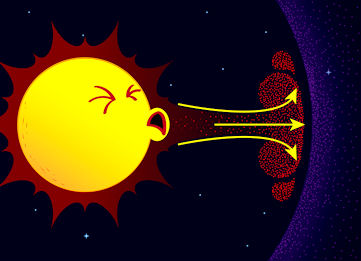
Action of the solar wind
Our detailed knowledge of planets is limited to those located within the heliosphere; Mercury through Neptune, the dwarf planets like Ceres and Pluto, as well as several distant Kuiper Belt Objects like Eris and 2007 OR
10 (10). These objects exist within the 'rarefied atmosphere' of the heliosphere, where interplanetary dust is constantly removed over time and thus prevented from accumulating around these gravitational features to any great degree. The Sun, through the joint action of its charged solar wind and its dominant gravitational pull, creates drag on the interplanetary dust which then slowly spirals down into the Sun. It effectively acts like a cosmic vacuum cleaner, keeping its home free of dust (11).
How Physicists Think
It's generally assumed, a priori, that planets beyond the heliopause would be similarly clear of dust accumulation. It's assumed that planets beyond the heliopause would be as 'viewable' as those within. In other words, that the laws of physics pertain equally to the relative brightness of dark objects within and beyond the Sun's magnetic field. So, astrophysicists trying to gauge the theoretical apparent magnitude of Planet X (or, for that matter, a Planet Nine body) apply distance, size and albedo (or reflectivity) to their calculations, just like with the other solar system planets. These calculations come up with figures that are within range of current detection techniques. Yet there are no candidate objects recognised by the mainstream. So, they wonder how it's possible that Planet X has avoided direct detection given the considerable surveying power at their disposal.
What they do not consider is that there may be some added complexity at work, skewing the actual numbers.
And why should they have to? After all, until the recent realisation that Planet X is for real took hold in the scientific community, scientists didn't really have to deal with such problems. All of the predicted objects they had attempted to observe, based upon supporting indirect evidence, lay within the heliosphere. So naturally they obeyed the rules. The absence of 'mythical' planets like Nibiru, Planet X, Nemesis, etc, in visible and infra-red sky surveys could be simply put down to the lack of their actual existence. It was not necessary to explain their absence from the data. Only researchers like myself, and a few die-hard astronomers who kept an open mind about Planet X, ever needed to ponder these issues.
Interstellar Fluff
Several fringe Planet X researchers have proposed imaginative ideas to explain the gap between the predicted body and the (thus far) dearth of extra planets: Exotic matter, cloaking devices, Dyson spheres, dimensional disruption, conspiracy. I'm sure there are others. These seem to me to be an unnecessary leap. instead, could simple dust prove the answer? I believe so.
Beyond the heliopause, the mechanism for removing interstellar dust from the outer solar system works much slower than within the heliosphere. The galactic stream is far less efficient than the Sun at clearing 'fluff' out. Mechanisms for the clearance of interstellar medium have been proposed, although data from various spacecraft has shown that there is actually an anomalously high level of large dust grains penetrating the outer solar system (12), the source of which remains unresolved (13).
There's plenty of interstellar medium around between the stars, too. Anyone who has viewed the beautiful images of nebulae taken by the Hubble Space Telescope will recognise the immensity and grandeur of these dusty structures. Gigantic molecular clouds, 'local fluff', dark nebulae and the more traditional star-forming regions, accrue as a result of the destruction and recycling of stars.
The Sun, like all stars, bobs about as it cycles around the galactic core, moving in and out of these various regions, with their varied density of interstellar matter. As we sometimes hear, the heliosphere offers the fragile Earth some protection from such rich zones of matter, as well as tempestuous novae, etc. But what of planets beyond this zone? Are they not rudely exposed to the flotsam that drifts on the galactic breeze? If sizeable enough, might these 'interstellar' planets, located in the outer solar system beyond the heliopause, not pick up some of this material into their area of influence?
Much of that matter will fall to the planet's surface. Much of it will organise itself in time into rings, and eventually accrete into planetessimals (14). But astrophysicists who study the formation of planets from protoplanetary disks note the complexity inherent in these dusty rings and shrouds. Collisions between haphazardly orbiting bodies can lead to a cascade of destruction which offsets the natural drive towards order, as noted with the substantial nebula of gas surrounding Formalhaut b (15). Perhaps this balance is undermined in interstellar space where that cleaning mechanism, so important within the heliosphere, is significantly less powerful. A more chaotic environment may prevent the attainment of order, and prevent the accumulating dust from settling.
What I'm proposing is that planets located beyond the heliosphere are routinely subject to different environments and mechanisms, which allow them to accrue dusty nebulae around them. It has been shown that dense dust clouds are more resistant to the sweeping effect of the galactic stream than looser collections of gas (16), and so it seems likely that a dense local nebula held in place by the gravitational and magnetic influence of a substantial inner planet would retain its identity over time. These localised nebulae act in the same way as their larger cousins - holding in the heat of the interior objects, and shielding planets from view.
Space Croissant
Assuming that I'm on to something here, let's consider what the shape of that dense local nebula might be. As we have seen, the shape of the heliosphere has not turned out to be comet-like (as theoretically predicted), but instead croissant-shaped, featuring two substantial but relatively short jet-streams (17). As the NASA website points out (8), this bow-shock shape is similar to that of the variable binary star BZ Cam's unusually strong stellar wind as it ploughs through surrounding interstellar gas (18). So, in these cases, the movement of a substantial magnetosphere through the galactic interstellar medium stream moulds the heliosphere into a crescent shape, rather than a long-tailed comet shape.
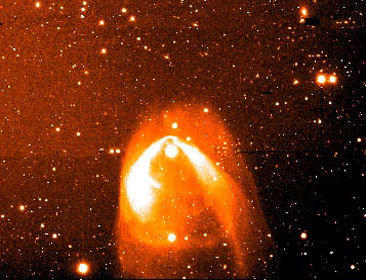
BZ Cam's Bow Shock Image Credit: R. Casalegno, C. Conselice et al., WIYN, NOAO, MURST, NSF (18)
I think this same effect would be seen with a dense localised nebula surrounding a substantial planet located beyond the heliosphere. Massive star-forming nebulae often feature 'fingers', stretched out by jet streams and powerful stellar winds from young stars.
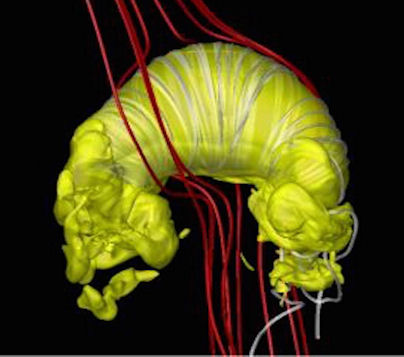
The yellow shape is the heliopause, the boundary between the heliosphere and the local interstellar medium.
The gray lines are the solar magnetic field lines and the red lines are the interstellar magnetic field (8).
Credits: Merav Opher (17)
These features indicate the complexity of forces at work within these nebulae. On a lesser scale, I think that a raft of forces are at play within local nebulae that I think immerse planets beyond the heliopause. These include the galactic tide, the magnetosphere of the planet, the forces at work at the termination shock of the heliopause, and a dynamic interplay of dust accretion and collisional cascades of planetessimals located within this complex environment.
Winged Disk
Again, in the absence of the dust-removal mechanisms triggered by the Sun, I believe that the 'normal' dispersal of accruing interstellar dust is absent, which plays a part in the appearance of these outer solar system structures. Specifically, I suggest that a substantial Planet X object, which permanently resides beyond the heliosphere, might have wrapped itself in a dust nebula that takes on the shape of a winged disk. Symbols of the winged disk from ancient Egypt and Mesopotamia are generally thought to depict a solar deity, but perhaps their visual identity more closely resembles a different phenomenon. I can easily imagine how the complex dust nebula I have argued for here could become a symbolic winged disk. A substantial Planet X body may well have a contingent of moons/planetessimals as well, which would add to the complexity of this shape, perhaps taking the form of the snake-like uraei often noted in ancient Winged Disk symbolism.

Inevitably, questions arise from such speculations. For instance, such a model would only work for a Planet X body which remains permanently beyond the heliopause. This is necessarily the case because once such a body traversed the termination shock and entered the heliosphere, the dust cloud would be subject to the disruptive force of the solar wind. Such a force would exacerbate the crescent-shape of the nebula, as it became driven back by the solar wind (like the coma of an outgassing comet). But, inevitably, the dust cloud would dissipate, particularly true if the Planet X body was subject to frequent perihelion passages. If this object is to remain well beyond the 80AU termination shock, then it could not be visible from Earth at any time during its orbit. Only a closer inspection of this phenomenon would reveal its true appearance.
Wider Implications
The proposed Planet Nine body is not thought to get anywhere near the heliopause, and would therefore not be subject to the forces of the solar wind. If my proposal proves correct, then Planet Nine is shrouded in an immense crescent-shaped cloud of dust which obfuscates its appearance both in visible light and infra-red. The usual calculations about its apparent magnitude simply do not apply. Furthermore, we are searching for a nebulous phenomenon rather than a pinpoint light-source, undermining standard presumptions about how this object will appear, and how easily it can be imaged.
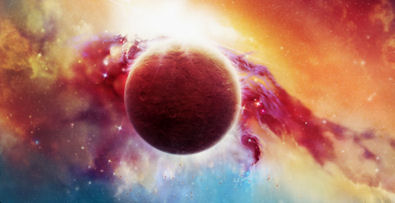
My hypothesis has wider implications than simply what is happening in the outer solar system beyond the heliopause. It is already the case that planetary scientists are puzzled over how a Planet Nine body might have come about in the first place (19). The general model about planet formation fails to deliver such far-flung worlds, requiring astrophysicists to devise chaotic, fluctuating conditions within the early solar system to tease out such bodies from their calculations. The problem they have is simple enough: the density of the protoplanetary disks circulating young stars is insufficient at these distances to form substantial planets.
My hypothesis side-steps this issue by allowing for life-long planetary formation beyond the heliopause. Clearly, the general model still stands for planets forming from protoplanetary disks early in the life of a given star. But in addition to this, I consider it possible that additional substantial bodies can accrete over time beyond the heliopause, driven by irregular influxes of interstellar material as the Sun moves through regions of varying density (note also that the heliopause is a dynamic boundary, capable of being pushed back by strengthening external forces (20)). To look at this a slightly different way, where astrophysicists consider the statistically unlikely capture of exoplanets from passing stars, I'm thinking about the external capture of parts of immense dust clouds as the Sun moves through them, leading to continuous planetary evolution beyond the heliopause over the lifetime of the solar system.
If this is the case, then one would imagine that there would be a considerable bounty of exoplanets lying in wide orbits around medium to old-aged stars. Assuming that they don't take on actual brown dwarf proportions (i.e. >18Mj, which would drive out the dust through their own diminished stellar winds) these distant planets would each be wrapped in their own nebula shrouds, obfuscating their appearance and heat signatures. A substantial bulk of dark planets may thus lie hidden from detection, contributing towards the missing mass within the galaxy (current models don't allow for such far-flung worlds, and so don't build them into calculations of projected overall mass).
Indeed, perhaps even the majority of planets lie beyond their parent star's magnetic boundaries, completely counter to the normal notions of planetary formation based upon protoplanetary disk evolution alone? Coming back to my analogy about the Sun's clean house, I wonder whether beyond its walls lies a dusty garden full of dark, shrouded figures?
There is something else I raised in Rome that I have yet to share online, and will do so in the future, no doubt. Stay tuned!
Addendum
The following couple of paragraphs was included in a paper by Paul LaViolette in 1993, which seems to pick up similar themes about the existence of a shroud of dust wrapped around the solar system. It's based upon the findings of the Ulysses spacecraft, which I mentioned in my February 2016 paper within the context of similar findings from more recent probes about the mysterious intrusion of large dust grains through the heliopause.
I need to read a bit further into this, particularly regarding Beta Pictoris, but wanted to quickly share it in this month's blog:
"In the absence of the above evidence, some might be inclined to surmise that the interstellar dust discovered by Ulysses, originally approached the Solar System from the direction of Hercules, opposite to the Sun's movement through the interstellar medium, and that it had subsequently become deflected by some 60° to its present Galactic center radiant as a result of solar magnetic field interactions. Such an interpretation would attach no particular significance to the Ulysses observation that the dust is currently passing through the Solar System from the Galactic center direction. However, evidence pointing to the prolonged entry of interstellar dust and gas from a Galactic center/ecliptic direction, compels us to conclude that it is no mere coincidence that Ulysses has observed dust coming from this particular heading and that some other agent is responsible for directing the dust on its present course.
"I would suggest that the dust originates from a circumsolar dust sheath that is concentrated toward the plane of the ecliptic in a fashion similar to the disk girdling the star Beta Pictoris and that is co-moving with the Sun. Infrared observations confirm the existence of dust sheaths around other stars in the solar neighborhood, leading to the conclusion that our Solar System is similarly shrouded." (21)
Written by Andy Lloyd, 23rd June 2016
References:
1) 'Planet X Event' See my review:
2) Andy Lloyd "The Shroud Hypothesis as part of a Dark Star Solution" 9 February 2016
andylloyd.org/darkstarblog35.htm
3) Andy Lloyd "Young Free-Floaters" 12 February 2016
andylloyd.org/darkstarblog37.htm
4) Konstantin Batygin & Michael Brown "Evidence for a Distant Giant Planet in the Solar System" The Astronomical Journal, 151:2, 20 January 2016,
5) Andy Lloyd "The Shroud Hypothesis" 12 January 2015
andylloyd.org/darkstarblog22.htm
6) Andy Lloyd "The Cumulative Effect of Intermittent Interstellar Medium Inundation Upon Objects In The Outer Solar System" Feb 2016, DOI: 10.13140/RG.2.1.5112.5526 - an updated version (22/2/16) is available here:
7) "What shape is the heliosphere?" Astronomy & Geophysics, 56 (2): 2.8., 2015
8) Karen Fox "NASA-Funded Study Finds Two Solar Wind Jets in the Heliosphere" 3 March 2015
9) Space.com staff "Fluffy Mystery at Edge of Solar System Solved" 23 December 2009
10) Preston Dyches "2007 OR10: Largest Unnamed World in the Solar System" 11 May 2016,
11) J. Klačka "Comparison of the solar/stellar wind and the Poynting-Robertson effect in secular orbital evolution of dust particles", Monthly Notices of the Royal Astronomical Society, 436: (3): 2785-2792, December 2013
12) B. T. Draine "Perspectives on Interstellar Dust Inside and Outside of the Heliosphere", Space Science Reviews, 143: 1, pp 333-345, March 2009
http://arxiv.org/abs/0809.5233
13) Mikhail Belyaev & Roman Rafikov "The Dynamics of Dust Grains in the Outer Solar System", The Astrophysical Journal, 723:1718–1735, 10 November 2010
14) Peter Goldreich & William Ward "The Formation of Planetesimals", The Astrophysical Journal, 183, pp. 1051-1062, 10.1086/152291, August 1973,
15) Scott Kenyon et al. "Fomalhaut b as a Cloud of Dust: Testing Aspects of Planet Formation Theory", The Astrophysical Journal, 786 (1), March 2014
16) Jeffrey Kenney et al. "HST and HI Imaging of Strong Ram Pressure Stripping in the Coma Spiral NGC 4921: Dense Cloud Decoupling and Evidence for Magnetic Binding in the ISM", 12 June 2015,
17) Merav Opher et al. "Magnetized jets driven by the sun: the structure of the heliosphere revisited", Astrophysical Journal Letters, 800:2, 19 February 2015
18) Robert Nemiroff & Jerry Bonnell "BZ Cam Bow Shock" 29 November 2000
19) Andy Lloyd, "Haystack Latest: The Hunt for Planet Nine Goes On..." 5-29 April 2016
andylloyd.org/darkstarblog37.htm
20) G. P. Zank & P. C. Frisch, P. C. “Consequences of a Change in the Galactic Environment of the Sun”, Astrophys. J., 518, 965-973, June 1999,
21) Paul LaViolette "Anticipation of the Ulysses Interstellar Dust Findings" Eos 74(44) (1993): 510-11 with thanks to Michael
Planets IX, X, XI etc, etc
Very much in keeping with the concepts discussed above, a recent astrophysics paper looking closely at the effect of a Planet Nine object upon the the original six extended trans-Neptunian objects has flung up the possibility of yet more planets lurking in the outer solar system wings (1). They have been wheeled in to counter-balance what is perceived by some academics to be a destabilising influence enacted by Planet Nine on some of these objects over time.
"
We find that a nominal Planet Nine can keep the orbits of (90377) Sedna and 2012 VP113 relatively well confined in orbital parameter space for hundreds of Myr, but it may make the orbits of 2004 VN112, 2007 TG422 and 2013 RF98 very unstable on time-scales of dozens of Myr, turning them retrograde and eventually triggering their ejection from the Solar system. Far more stable orbital evolution is found with slightly modified orbits for Planet Nine." (2)This analysis has not exactly pleased Dr Mike Brown (1), the lead researcher behind Planet Nine. Yet the research group behind it are significant players, whose early work on the alleged cluster (3) he cites prominently in his own paper (4). Furthermore, this analysis comes after a similar finding by astronomers from Harvard who, when scrutinising astrometry data on Pluto and other trans-Neptunian objects, had argued for either the existence of a second perturbing planet, or a significantly more massive Planet Nine body (5). It's fair to say that the waters are getting increasingly muddied the more theoretical work is done on Planet Nine. That's not to say that Planet Nine is absent from the frame entirely, just that it's not particularly easy to pin down, and might turn out to have company!
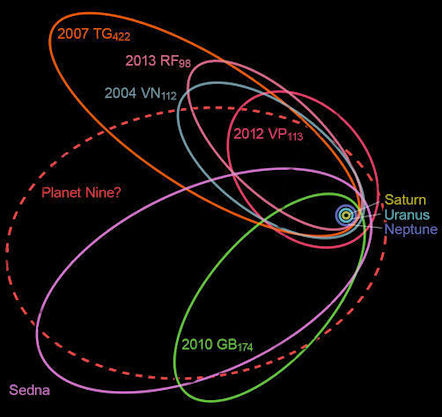
The alternative 'aligned' configuration for Planet Nine's proposed orbit
I wonder whether a similar analysis would yield better results if conducted upon the alternative (but later dismissed) proposal of an 'aligned' orientation for the orbit of Planet Nine with respect to the cluster of six objects affected (3). To illustrate this orientation, I have taken the liberty of re-working the Caltech boys' original image. If the aligned orientation is correct (and Brown and Batygin were pretty sure it isn't (3)) then everyone's looking in the wrong direction! But it might explain why analyses of the data undertaken by different research groups are coming up with more nuanced views of this object, and its effect upon the cluster of 'extreme KBOs' (eKBOs) originally noticed by Trujillo and Sheppard (6).
It's also interesting to note, then, that another current paper attempting to piece the jigsaw together does not rely on the anti-aligned orientation favoured by Batygin and Brown (7). Instead, it concerns itself with resonance relationships between the six members of this cluster, potentially in-step with a hypothetical planet whose orbital period is approximately 17,000 years:
"We point out hitherto unnoticed peculiarities of the orbits of the eKBOs mentioned above: we find that the orbital period ratios of these objects are close to integer ratios. This helps us identify a particular orbital period of the hypothetical planet which is in simple integer ratios with the four most distant eKBOs. That is, we identify mean motion resonances between these eKBOs and the hypothetical planet" (8)
In terms of mass, the authors conclude that the hypothetical object would have to have at least ten Earth masses to maintain a long-term resonant relationship with the four outermost eKBOs. Beyond that, the position of the planet takes on a wide selection of possibilities, with a broader range of inclination.
Written by Andy Lloyd,
23rd June 2016References:
1
) Paul Seaburn "New Evidence For Existence of Planets Ten and Eleven" 15 June 2016mysteriousuniverse.org article
2) Carlos de la Fuente Marcos, Raúl de la Fuente Marcos & Sverre J. Aarseth "Dynamical impact of the Planet Nine scenario: N-body experiments" Monthly Notices of the Royal Astronomical Society: Letters, 460 (1): L123-L127, 21 July 2016
3) Carlos de la Fuente Marcos & Raúl de la Fuente Marcos "Extreme trans-Neptunian objects and the Kozai mechanism: signalling the presence of trans-Plutonian planets" MNRAS, 443, L59-L63, September 2014
4) Konstantin Batygin & Michael Brown "Evidence for a Distant Giant Planet in the Solar System" The Astronomical Journal, 151:2, 20 January 2016,
5) Matthew Holman and Matthew Payne "Observational Constraints on Planet Nine: Astrometry of Pluto and Other Trans-Neptunian Objects" The Astronomical Journal, 152: 4, 30 Mar 2016,
6) Chad Trujillo & Scott Sheppard "A Sedna-like body with a perihelion of 80 astronomical units", Nature, 507, 471-474, 27 March 2014,
7) Planet Nine
wikipedia.org/wiki/Planet_Nine
8) Renu Malhotra, et al "Corralling a distant planet with extreme resonant Kuiper belt objects", The Astrophysical Journal Letters, 824: L22, 2 June 2016,
arxiv.org/pdf/1603.02196v2.pdf
Awake and Aware Conference, Watford, 10th July 2016
I'll be speaking at the "Awake & Aware Conference", hosted by UFO Academy, with Kerry Cassidy of Project Camelot.

My presentation during the afternoon of Sunday 10th July will last just over an hour, on the subject of the hunt for Planet X:
"New scientific discoveries seem set to confirm long-standing predictions about Planet X, many of which are deeply contentious. In this presentation, Andy Lloyd will discuss the remarkable repercussions of an imminent planetary discovery."

You can keep informed of updates by following me on Twitter:
![]()
Or like my Facebook Page: https://www.facebook.com/darkstarandylloyd